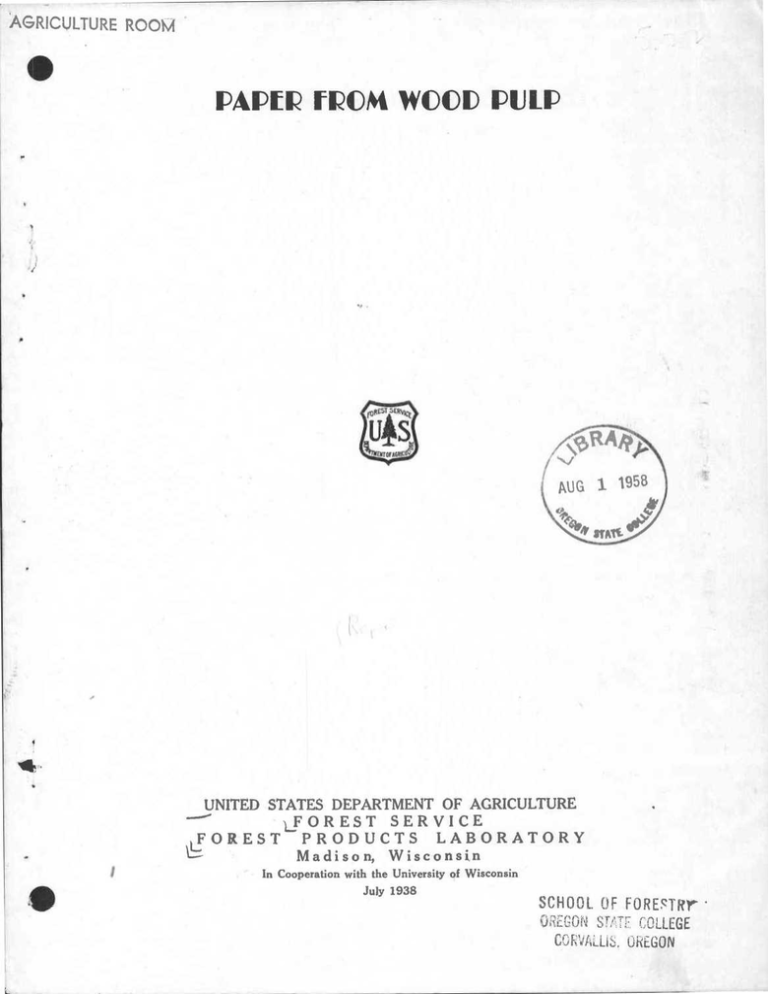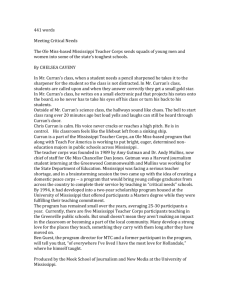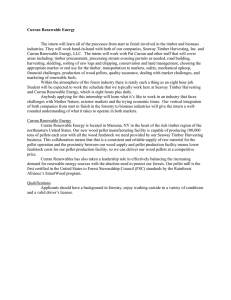PAPER FR®M WOOD PULP F UNITED STATES DEPARTMENT OF AGRICULTUR E
advertisement

AGRICULTURE ROOM PAPER FR®M WOOD PUL P UNITED STATES DEPARTMENT OF AGRICULTUR E LFOREST SERVIC E FOREST PRODUCTS LABORATOR Y Madison, Wisconsi n F In Cooperation with the University of Wisconsi n July 1938 SCHOOL OF FOREFTR r O ST','',TF COLLEGE CO ',LLIS, OkLGON • 1Fl~ '5 PAPER FROM WOOD PULP t& e tY Re's the 1• 111 _ ' n interw bebveen Dr . Carleton E . C1rran;' ief of :and ~r Di stop of tai';r ' s!b' boduct s #e-s 2oxwst SeIiee, ligibarso.iti ficl st:- '= cy~: . 11 y 29,L' 4 -. a,,•_":~_ i and Ho .tpartr ffimd of the II 1 1' . 1 11 1- -r 1 JOHN BAKER : Today we're going to hear a pape' . t'tory from the Forest: Products gifts IA - . Laboratory, Madison, Wisconsin . Paper is one of + i, J:-,'"t " forests have made to modern civilization . Paper o_ `- bur thoughts,- i n writing and printing . It helps educate our children It wraps our g .Oc ds,, . . It records our obligations and even pays our bills . Now we're going t o hear an authority tell us how paper is made, from wood pulp . Are you_ .ready,Mr . Roen? ROEN : We are ready, John Baker . By we, I mean Dr . Carleton E . Curran, Chie f of the Pulp and Paper Division of the Forest Products Laboratory, Madison , Wisconsin -- and Yours Truly . Yours Truly isn't much of an authority o n paper yet, but he has ambitions . Doctor Curran, I have here a sheet of typewriter paper, the brown paper bag I brought my lunch in, a newspaper , a magazine, and a book . CURRAN, : That's a mighty slim start, Mr . Roen . ROEY: (SURPRISED) paper is us e '. ypi6-1 collection of wha t CURRAN : Okl, besides biooaks•, -mIgazinea ,1 hand n shipping_con'tail ers, corA w l rUgb, mats, felts, p dressings, artificial ]leather - - Arti g icial- l0:a+t , ", .stiitvades, tawels, h:,n'dkerchte v .; 'lil:N §, l1 sbEs t u ' CUl L d ates, : 010 N: I give ;up, IZo•ctor :Z - . . I startled. out on paper, but I guess I'll • imin to_ .,s 1 _ r 's . , . tc l. . i4 , :ItTe .1 ns i . :' *authority f 11 ROEN : Might as well learn from the ground up . Or rather from the soil , that produces our forests, that produce -- how much of our paper ? CURRAN : Well, at least nine-tenths of it . In general, wood pulp is by fa r the most important raw material for paper . ROEN : Isn't paper from wood a very modern development ? CURRAN : Comparatively so, as we know it . Wood pulp has made paper chea p and abundant . It has put books, magazines, and newspapers into the hand s of practically every one who is able to read . From its two original uses - writing and printing -- the uses of paper have spread to cover hundreds o f daily needs . ROEN : Say, what about grass and annual crop plants, for paper . I've hear d that these raw materials are even cheaper than wood . Is that true ? CURRAN : Only partly true, and only in the case of a few special products . You see, Mr . Roen, the essential substance of paper is cellulose . Wood i s the most compact and the cheapest source of cellulose yet discovered . ROEN : What's it like? Cellulose . CURRAN : Well, it's something like cotton . In fact, cotton is cellulose in a fairly pure form . Wood is full of it . Wood fiber is largely made o f cellulose . ROEN : Could you say, then, that wood is largely made up of little pieces o f cotton, stuck together ? CURRAN : You might not be so far wrong, at that . ROEN : Maybe I've discovered something ! CURRAN : Well, you've learned something . ROEN : How do you make pulp out of wood ? CURRAN : Wood pulp falls into two main divisions, mechanical and chemical . To make mechanical pulp, the wood is simply fed to a wet grindstone, and th e fibers are torn loose and floated away as pulp . Chemical pulps are quite different . They're made by cooking wood, in the form of chips, with chemicals , acid or alkali . ROEN : And I suppose different chemicals affect the final product -- But how ? CURRAN : Well, in the same way your dough ingredients make cake or cornbrea d out of flour or meal . You use chemicals to suit . 4llk ROEN : That's plain enough . Sometimes I want cake, and sometimes I'd rathe r have cornbread . R117S -2- CURRAN : You Want difeWeAt . _ki.Nnds o f . paper• four 't 'fferent Vurposes . Just fo r r you .haiv a . here,, This is a illustration, take this= she of t yp wri_F . l fir ness to it . fgi:rly'4ard, w :i tY;; io -of sna good piece . It's tough,_ paper , fir bleachedte These qualities are what et - in a h .ih generally from spruce . k ROEN : Then my typewriter paper came from somebody's pre f•c e° . =IRAN : Quite likely, Now let's look at your book . reading that long novel? ) Mat -- Yotii z ROEN : Still and yet . What kind of tree is- it made of? '(0t forest, I i i .l d say, considering the lengt of the novel, ) CU 1 : Well, lot's look at the paper . Here -- feel it : &efit in textur= rather light in weight, nontransparent, soft whito in color . %him -heel •E.01 is largely ble.aohed soda pulp, made from short-fibe:red hardwood -;.. -like poplar, ROEN : (Well, it's a "poplar" book .) Now what kited of tree furnished the woo d pulp for this heavy brown paper bag ? CURRY : In all probability this is a specimen of unbleached sul hr tley or brown kraft,. made in such large vahtit .ies from the seuihern pines . Many papers ar e mixtures . This newspaper you have here is a mixture three parts mechanica l pulp to one part chemical . .The chemical pulp makes it stronCVf . ROEN : Doctor Curran, you'veigot me interested . If I'd'com. would you sham . me through your paper-pulp laboratory ? p Ito Edison, CURRAN : Certainly . Be-glad to . When can you come ? ROEN : Next week? Thursday or Friday? I. CURRAN : Fine, You come along, and we'll show you how we're -expdrtmei t : ix ; with differm,t kinds of American woods -- to :pep what kinds of patie - . i r e best fittea for . jIttit To increase our paper production, yoga . moan ? CURRAN : Not primarily ; that will take care of itself . 4t wtEterestec_ in is to broaden the forest base of paper production -- .to, d1$ the tpre of . burden from a few weeds and share it with others that we ROEN : That sounds like a big job . CURRATh It naotnbtedly is . But the United States wouldn't nae,d to lode to foreign c vi. es for a ei'ngle -tick of pulpw od if we co> Avg= our logging . ;flemand s wastes and our ' less-wed species' into t ri +• 1'41 N •Tha wou mean a -great clod in an economic Fray . 1- CURRAN : It would mean added values for forestry . Employment for thousand s of workers . New jobs for capital . New support for rural and town communi ties through tax revenues . For example, take the fairly recent pulp an d r paper development in the South . One of our first pieces of research, whe n • 113 the Forest Products Laboratory was founded in 1910, was to pulp and proces s -* a typical selection of southern pines . The influence of that research ha s Ir '' aen steady and continuous in the growth of the southern industry . I am sure you have also heard of the splendid work of Dr . C . H . Herty at Savanna h • Georgia, on the southern pine problem . His sudden death on July 27 is a 2 distinct loss to the South and to the nation . As; ROEN : I am shocked to hear of Dr . Herty's passing . Didn't I see something about him recently in the news reels ? : Very likely . Did you hear that a mill is now being built in Eas t Texas to make newsprint? A year from now you may be reading the headline s on what was once a pine tree . CURRAN : Very much the same, but made differently . And the new method is a better forestry proposition . It's what we've been advocating for pine fo r many years . ROEN : How does the forestry angle come in ? . CURRAN : Simply in this way : If you use the present sulphite method, you'v e got to take young pines, without any heartwood . The more newsprint you mak e that way, the less chance you have of any young growth coming along to re- stock your woods . By using the sulphate method, as they intend to do at a proposed new mill in Texas, you can pulp bigger and older trees, and g o easier on the young stock . Another way out is to use hardwoodsi We hav e some interesting results in this line too . ROEN : You know, it's not my worry -- but they say the way newspapers stri p off the forests is a caution . I forget how many acres they use for on e Sunday edition . CURRAN : That proves the need "of getting newsprint production on a much wide r basis nationallyi As a matter of fact) in the South, the Federal and Stat e Forest Services ate going after the cutting problem right at the start . They're showing the farmers that they are money behind when they strip thei r woodlands bare instead of marketing pulpwood as a regular crop . It figure s out in dollars and cents . ROEN : Seems to me you've given us a tremendously practical research story , Doctor Curran . I suppose woods owners in other parts of the country also hav e a stake in the pulpwood situation . CURRAN : Indeed they have . The work of the Forest Service is for all th e country . Our experiments have covered the pulping of over 100 differen t R1178 woods . The work is divided into regular regional studies -- including th e woods of the Lake States, New England, the Central region, and the Pacifi c Coast, as well as the South . ROEN : Many thanks, Doctor Curran, for giving us this view of pulp and pape r from American woods . I'm going to ask you a good many more questions when I make my tour of the Forest Products Laboratory next week . Would nex t Friday be convenient for you ? CURRLN : Friday it is . We'll be looking for you . SCHOOL OF FORESTR r OREGON STATE COW! L.t; E CORVALLIS, OREGON R1178 -5-




